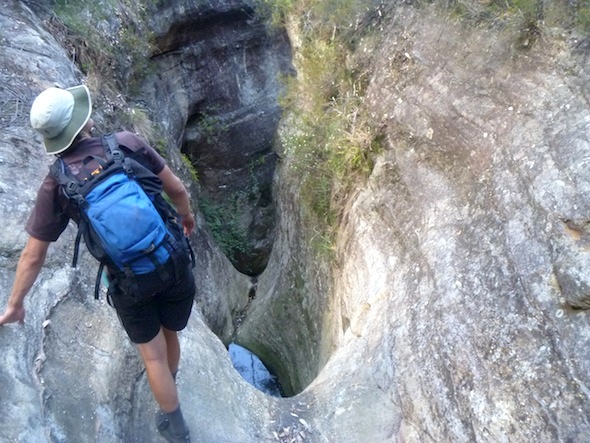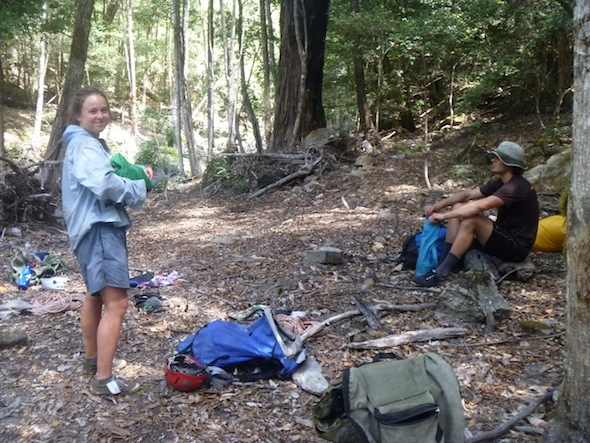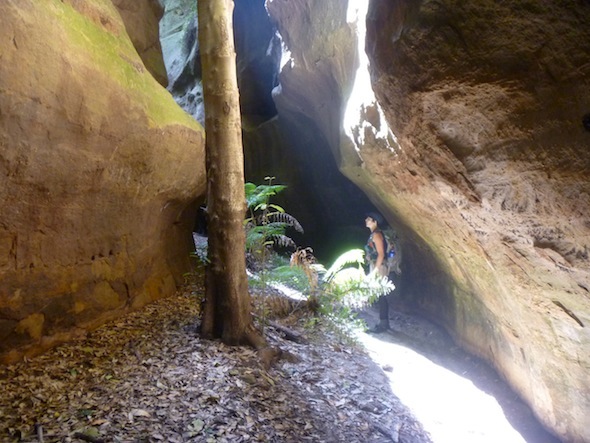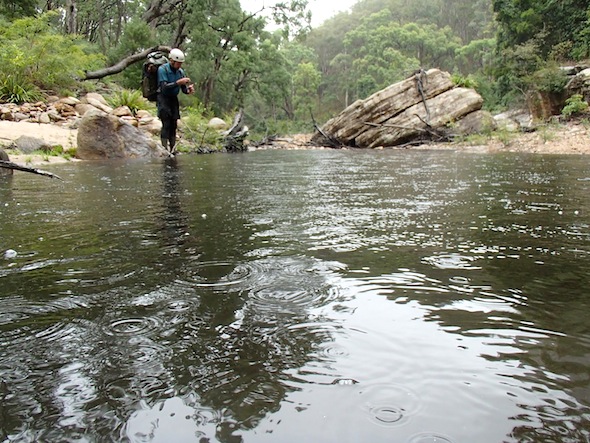Party: Adrian Spragg, Mariacristina (Mary) Merlo, Helen Margherita Smith and Kosta Seiler
Last year’s week of canyoning in the Coorongooba Labyrinth was the highlight of 2012 for me and I was so looking forward to getting back to the region this year on T2’s planned six day trip. Mary and I had three days of canyoning out of Glen Davis on the previous weekend, and returned home to an email from T2, who had come back from Glen Davis a day earlier, that he was going to have to bail due to work commitments. My offer to take over the trip was to no avail, the dominos continued to fall, and could not be raised by the suggestion of a three day trip.
Helen returned from the wilds of New Zealand and with Mary held firm. Re-advertising on the SUBW site brought in Kosta, and all agreed to increase the trip to four days.
And so it was that we dossed down after midnight at the excellent Glen Davis Camp Ground with our friends the mosquitoes and sparrows.
I had unsuccessfully been trying to ring a local landholder for access, so we decided to rock up on the doorstep to try our luck. A padlocked gate with a neat sign that read “Private Property Keep Out” well before the homestead killed that idea, so Plan B was to drive around to the next closest access and walk from a public road.
A local pointed out that we were crossing private property there too, so with some trepidation we fronted the landholder who very kindly advised us which gates to drive through and that he would clear our access through an adjoining property by email.
Seeing a goanna, wombat and wedgetail eagle in the first 10 minutes of walking was a good sign. We made our way up a large creek, which had high (25m!) eroded banks and many tree pileups that indicated recent massive flooding (probably from 2010).

The initial steep sides had me thinking this was going to be painful, but then they eased off and we often crossed and recrossed the creek until lunch in the shade of a coachwood forest. A welcome relief from the approximately 33 degree heat.
We staged some photos to show our lapsed leader was with us in spirit, then pushed on to our campsite at a creek junction. (Mind you, one can be forgiven for quoting almost verbatim from T2’s Coorongooba report from last year: “he committed a cardinal sin and should be forever known as ‘The Piker'”. In which case the nomenclature P2 replaces T2.)
We made our way up a side creek, climbed out of it, and then around to abseil into a small unpromising looking canyon. With more abseils, we realised how wrong we could be. Welcome to the Wollemi! Dry caverns, trees growing between high walls, effective tunnels, we were totally enamoured by the time we exited to our creek.




We climbed upstream, entering parallel canyon walls and wondered how we would climb around any abseils we might encounter. However, it turned out to be a walk through canyon, with constricted side slots along fault lines that required investigation. Helen was captivated by the pair of friendly geckos we encountered in one of these.


From our turnaround it took us an hour to retrace our steps to our campsite. In hindsight we would have been better making our way up the second canyon, and climbing out over a saddle to come down our first canyon, but our choice reflected the lack of knowledge we had on the canyons we were visiting.
We got a fire going in the fading light before washing off the day’s sweat in a pool, cooking dinner and dispensed with putting up flies. Helen set up her motion camera, and warned us where not to go to the toilet!

Day 2 – Australia Day! Woo hoo. We set off up a creek and at the junction of two canyons dropped our packs and searched for a route out. Adrian tried the unconventional, Kosta – the rock climber – the direct, and Helen and Mary found the most practical, meeting up with Kosta half way up.
Up the ridge through thick scrub, until we dropped into a creek which became a canyon. Déjà vu – this one also had no abseils. Initially great effort was spent on bridging, but this soon became irrelevant, though the wades never quite reached swims.
Over the weekend we often had rock spiders scampering in front of us as we squeezed through, but at one pool just above the water line a black spider reared up and refused to back off. A warning was passed down the line for the first funnel web I remember seeing in a canyon.
At one point Kosta uttered the warning that a climb down was not midget friendly – too late, Helen landed flat on her back in a pool of water in peals of laughter.


Lunch back at our packs, then up Kosta’s route up the nose. Time consuming, this required some belaying, and pack hauling, as we were carting full bladders of water. We deposited these at a distinctive multi-stemmed angophora in the middle of the ridge, and less than 100m away came across a huge amphitheatre with an impressive overhung abseil into our next canyon.
Mary was in raptures and managed to take photos one handed with her new camera as she descended. Later we were to remember this massive camp cave wistfully.



The traditional description for the ensuing very narrow canyon is “constricted”, but maybe “constipated” would be more appropriate. At one point Adrian sat jammed between the canyon walls waving both feet and hands in the air – no need to hang onto the rope!
More tight abseils, smeared orange mud, and then the final walk out. But no, not finished yet! Adrian found it quite confronting when he could only pass through the piece de resistance by breathing out and squeezing his chest between the canyon walls.





You’ve heard it before: In hindsight we would have been better making our way up the first canyon, and climbing out over a saddle to come down our second canyon…

With full packs we made our way up the canyon walls for the third time today. By following Helen’s route, it was not as bad as we expected. We reached our water bladders and staggered up the ridge, around the base of the mountain and onto a narrow ridge to make camp.
Despite having the smallest pack, Helen surprised us by pulling out port, cheese and biscuits, with the Australia Day celebration taking place on a rock offering amazing views across various ranges of the Wollemi National Park. What amazing country!



With grand feelings of bonhomie the four musketeers decided to make a communal sleeping fly. It is possible the construction skills of a mix of pilates instructor/ kinesiologist, engineer, ecologist and accountant were never going to be up to scratch. Maybe it was not the cleverest idea to put up the flies after port and in the dark, but this was not apparent to our weary but happy band as we fell asleep.
At 3am when it started to rain, it did become apparent. The rain was blown in, the ponding required constant maintenance and dripping ropes provided much topic for discussion on design faults. We must have fallen into a slumber at some stage, but by 8am in the continuing rain it was apparent that all our sleeping bags were wet. With all our years of bushwalking experience, how could this happen? In the clear light of morning, the Italian, the German, the Swiss and the Scot for once reached unanimity that the rain was not forecast, so clearly the fault lay with the Norwegians.
On our third day we relocated to a camping cave conveniently found below us, but it was 12.30 before we headed up the hill and over to another canyon. This was the highlight of the trip. Very long, with numerous downclimbs, we enjoyed every minute of what we thought would be another walk through canyon.
There were many huge blue clawed yabbies, the largest most of us had ever seen.



It was not until we reached a creek junction that the first large abseil was arrived at. Three ropes were taken out, two were joined, and we were off.
Further abseils, and much bantering about the likelihood of one pulling a log belay down. Explanations of leverage and that there was no way this log could be catapulted by an abseiler’s weight were met with sceptical raised eyebrows. Mind you, there was a moment with the pull down test that we watched the rope almost slide off the log into the abyss.



At the bottom, we realised we were one rope short. Much discussion, with everybody maintaining their rope had been used on the first abseil. We are still trying to work out how to blame the Scandanavians for that one!
We came across a prone goanna, but when he was still there after our exploration of one of three side canyons, we decided that if he wasn’t dead he was definitely well on the way.



Our very long canyon finally relented at a creek junction and we were able to climb out along a ridge offering superb views in clearing weather before we returned to our camp cave on dusk.
Every day there was a concert morning and evenings by lyrebirds in the valleys below us or close to the clifflines above us. Enchanting songsters that left us with the feeling the world is in order. As the rain resumed through the night we all agreed our camp cave was a real gem.

Day 4. We climbed back onto our ridge, collected a remaining fly from our old camp and pushed along and up the hill which ended in a cliff, offering further stupendous views of our next canyon below us and mist wreathed hills beyond.
An unusual grove of pines below us had us catching our breath for a moment, but more careful examination confirmed they were cypress pines, often found in pagoda country farther to the south.



We made our way along the cliff top, then clamboured around below and into our creek. Helen could not resist hugging a massive angophora – how old must this tree be?
Our narrow canyon started soon after.
It was hard work trying to find purchase under water with our full packs jammed between vertical rock walls. Mary benefited from helpful shoves from behind from Kosta, whose longer legs appeared to give additional grip.
The walls widened a little to make negotiation less strenuous, but the first abseil still required grunting, puffing and wriggling of packs to reach the canyon floor.
The dark pools of water threatened but rarely delivered full swims, so our pack waterproofing was never put to the full test.

The canyon broke through the cliff lines and we stopped under an overhang for a final lunch. Down to the major creek and we were retracing our steps of the first day. A wash in the muddy waters of the raised creek paid lip service to getting clean.
Mary undid this by rolling off a mud bank into a turgid brown pool – accompanied by laughter which was the hallmark of our whole trip.

One could imagine that our path was facilitated by our previous passage, but we were preoccupied by how we would get our van across the creek which had been dry three days before. Elaborate strategies were laid and all agreed there would be no changing of sodden clothing until the car was out on the main road.
A wombat ran down the hill and scurried across our path and into his hole. A pair of wedge tailed eagles lifted off and flapped across the water logged paddocks. Yes, the world was still in order.
We dumped packs into the van and executed our plans flawlessly. Line up the van, gate open, controlled slide with a slight touch of the accelerator as it threatened to glide on the stock-churned mud into a gate post. All were poised to push across the creek, but it was unnecessary and then a final gate and we were out.

Bruce had asked us to drop by to show we had got out safely. Would we like a tea or coffee? A shower? Last week he could not have made this offer, but the 50mm of rain had topped up the house tanks.
Dinner at the Royal Hotel at Capertee was as good as the two Adrian and Mary had enjoyed there the previous weekend. Adrian introduced himself to a trio of canyoners at the bar and quickly discussed canyons each had done this weekend.
The drive home through Katoomba on Monday night was in pouring rain. In fact, Katoomba had 249mm rain in the 24 hours to 9am Tuesday – a January record since record keeping commenced 125 years ago. Sydney was wet enough as we drove through deserted streets, but with a mere 90mm rain in the same period.

Thank you for letting me vicariously enjoy this amazing trip with you. Great post of some great canyons that must be must be fairly remote